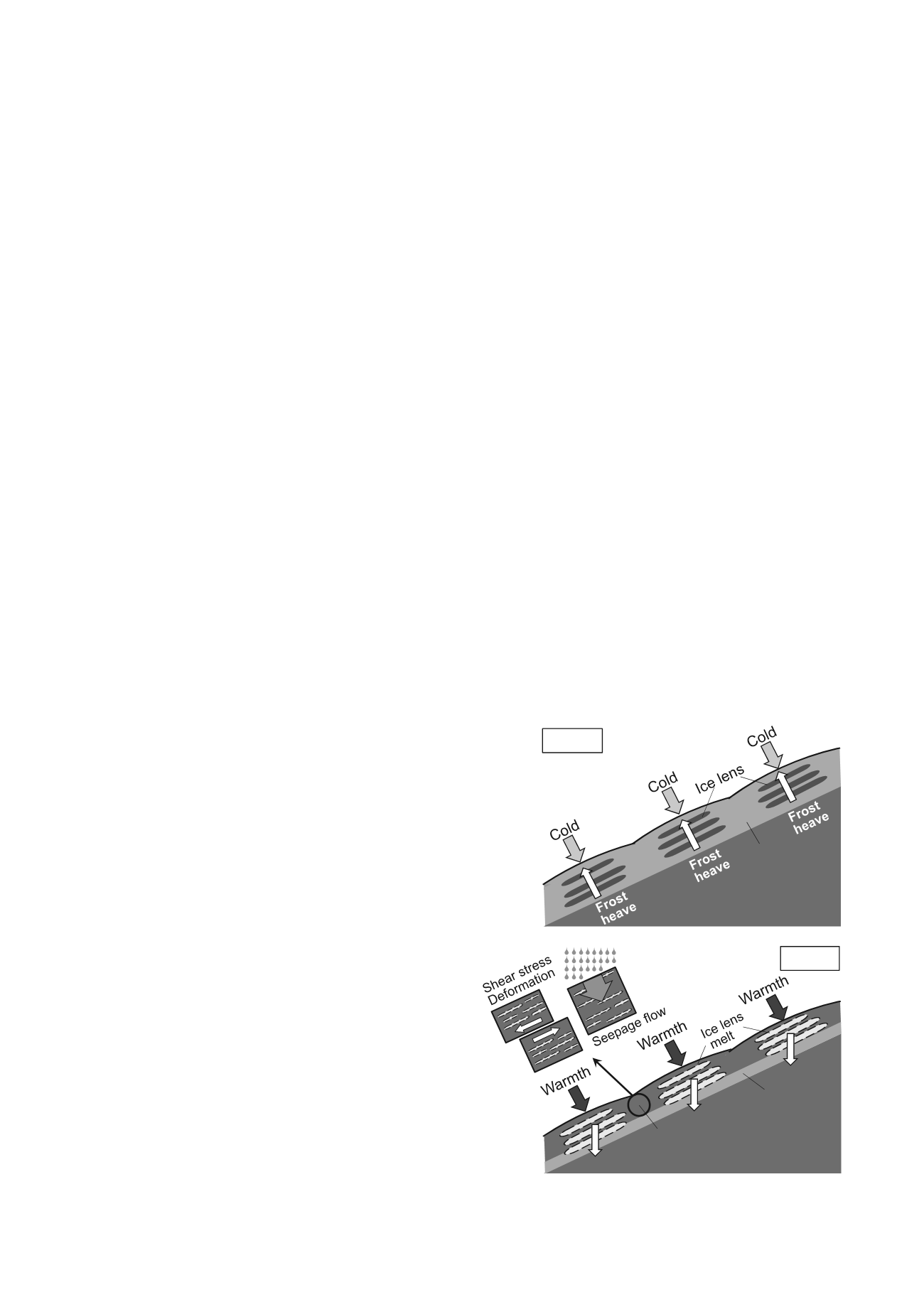
357
Proceedings of the 18
th
International Conference on Soil Mechanics and Geotechnical Engineering, Paris 2013
1
Effects of Freeze-Thaw History on Deformation-Strength Properties and
Permeability of Fine-Grained Soil
Effets de l’historique du gel-dégel sur les propriétés de résistance à la déformation et de
perméabilité des sols à grains fins
Kawaguchi T., Nakamura D., Yamashita S., Yamasaki S.
Kitami Institute of Technology, Kitami, Japan
Ishikawa T.
Faculty of Engineering, Hokkaido University, Sapporo, Japan
ABSTRACT: In cold and snowy areas, surface soils on slopes often move downward especially in early spring. Its moving caused by
repeated freeze-thaw cycles. If we properly evaluate slope stabilities and carry out effective slope protection works, we should
understand variations of strengths, stiffnesses, permeabilities, and so on in the cycles. By the way, it is known that repeated freeze-
thaw cycles make ice lenses within surface soil. They spread parallel to ground surface so they are arranged parallel to shear stress on
the slope. In this study we carried out frost heave tests that obtained changes of the void ratio and permeability in the cycle of freezing
and thawing, direct box shear tests that obtained strength-deformation characteristics in the cycles, and the bender element tests that
also obtained velocities of shear waves with vertical and horizontal propagation in the cycles. Then we conclude that the formation of
ice lenses made parallel to shear stress is important for mechanical properties of surface soils.
RÉSUMÉ : Dans les régions froides et enneigées, les sols de surface sur les pentes se déplacent souvent vers le bas, en particulier au
début du printemps. L’évaluation correcte de la stabilité des pentes et la réalisation de travaux de protection des pentes efficaces
devraient nous permettre de comprendre les variations de forces, rigidités, perméabilités, et ainsi de suite au cours des cycles. Dans
cette étude, nous avons effectué des tests de soulèvement par le gel qui nous ont permis d’obtenir les variations de l'indice de vide et
de la perméabilité dans le cycle de gel et de dégel, des essais de cisaillement direct à la boîte qui nous ont donné les propriétés de
résistance à la déformation au cours des cycles et des tests par élément fléchissant qui nous ont également donné les vitesses des
ondes de cisaillement avec la propagation verticale et horizontale au cours des cycles. Nous avons alors conclu que la formation de
lentilles de glace parallèles à la contrainte de cisaillement joue un rôle important dans les propriétés mécaniques des sols de surface.
KEYWORDS: frost heave, freezing and thawing test, permeability, strength-deformation characteristics, elastic shear modulus
1 INTRODUCTION
Winter
Surface soil of natural and artificial slopes in cold and snowy
areas, such as Hokkaido (the northernmost island of Japan),
moves downwards in early spring due to the cycle of freezing
and thawing (e.g. Ueno et al. 2010). A mechanism of this
phenomenon is conceptually shown in Figure 1. In winter, ice
lenses formed around freezing fronts within the soil on a slope,
then ice lenses grow, causing frost heave. In spring, ice lenses
thaw with increasing water contents of soil as temperature rise,
then soil begins to move or flow downwards by gravity. Slopes
often fail by snowmelt and rainwater. To evaluate slope stability
and select effective slope protection work, we should obtain
variations of strength, stiffness and permeability in the cycle of
freezing and thawing. As shown in Figure1, most of directions
of ice lenses are parallel to shear stress. However, there are few
studies focusing the directionality of ice lens.
Frozen
soil
Unfrozen soil
In this study, we pursued changes of the void ratio and
permeability in the cycle of freezing and thawing, covered soil
samples with various densities. To use soil samples containing
ice lenses, we developed a new method of the direct box shear
test, enabled to measure deformation-strength properties, and a
new method of the freezing and thawing test to measure
velocities of shear waves with vertical and horizontal
propagation, enabled to measure elastic shear moduli and
analyze anisotropic structures.
2 TEST APPARATUSES AND SPECIMENS
Three types of test apparatus were used in this study. The first is
a frost heave test apparatus according to JGS 0172-2009: Test
Spring
High water
content soil
Thawing
Thawing
Thawing
Unfrozen soil
Frozen soil
?
?
Figure 1. Mechanism of slope movement and slope failure in spring


